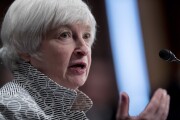
Mobile banking is now the primary access point for nearly half of U.S. households with bank accounts, according to the FDIC's 2023 National Survey of Unbanked and Underbanked Households. The survey found that 48.3% of banked households rely mainly on mobile devices for their banking needs, reflecting a nearly ninefold increase in the past decade.
"The use of bank tellers fell by more than half, and the use of online banking declined by more than one-third," survey results noted. "Since 2019, mobile banking has been the most prevalent primary method of account access."
Despite the rise of mobile banking, the survey found that approximately 19 million households — 14.2% of the nation — are still classified as underbanked, a term defined as a household relying on nonbank financial services even though they have a bank or credit union account.
Even as roughly 96% of households had access to traditional financial accounts in 2023, some 5.6 million households — 4.2% of the total — lack access to the banking system altogether.
The level of unbanked households in 2023 marks a modest decline from the 4.5% of households classified as such in the FDIC's last survey in 2021 and reveals significant increases in banking access in recent decades. In 2011, 8.2% of homes — the highest level on record — were classified as unbanked. The FDIC attributes this decline largely to improved socioeconomic conditions, including higher income and education levels.
However, that rosy picture belies racial disparities in which communities are banked and which are not. Nearly 10.6% of Black, 9.5% of Hispanic, and 12.2% of American Indian or Alaska Native households remain unbanked, compared to just 1.9% of White households. While those rates have declined in recent years, the disparities remain stubbornly difficult to dislodge.
Among Black households, the unbanked rate decreased significantly from 21.4% in 2009 to 10.6% in 2023, yet these households still represent a significant portion of the unbanked and underbanked. Black households were more than five times as likely to be unbanked, more than twice as likely to be underbanked, twice as likely to use prepaid cards, and more than twice as likely not to have traditional credit scores. Racial banking disparities also existed at every socioeconomic level.
"Among households with income between $50,000 and $75,000, 3.5% of Black households and 4.5% of Hispanic households were unbanked," the survey notes. "compared with 0.8% of White households [at the same income level]."
When asked about the barriers to banking access, 42.3% of unbanked consumers said they lacked the funds to meet minimum balance requirements, while 15.7% said they did not trust banks. For those who reported they were not interested in opening an account, privacy and bank fees were additional deterrents.
"Access to safe, affordable bank accounts is fundamental for consumers to be able to participate in and benefit from our nation's economy," said FDIC Chairman Martin J. Gruenberg. "This survey reveals that significant disparities in access to the banking system for minority, lower income, disabled, and single-parent households still exist and need to be addressed."






